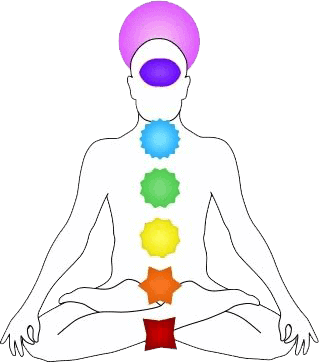Last updated on March 15th, 2024 at 12:31 pm
What are the 7 chakras and what do they mean?
What are the 7 chakras and what do they mean?
The concept of chakras – those swirling centers of energy within the body – might seem a bit mysterious if you’re new to yoga, meditation, or holistic healing. But don’t worry! While the idea of energy flows may feel abstract, chakras offer a fascinating lens for understanding your physical, emotional, and spiritual well-being.
The ancient philosophy of chakras describes seven main energy centers along your spine. Each chakra is associated with different aspects of your life, from your sense of security and grounding to your creativity, communication, and even your connection to the universe. When these chakras are balanced, you may feel more energized, focused, and at peace. However, imbalances can sometimes manifest as physical discomfort, emotional turmoil, or a feeling of being “stuck”.
In this article, we’ll break down the seven chakras in a clear and simple way. We’ll explore:
- What each chakra represents.
- How they influence your health and well-being.
- Signs that your chakras may need some attention.
Understanding chakras is a journey of self-discovery. So get ready to dive deeper into the fascinating world of your inner energy!

What is a chakra?
Chakras are often described as swirling vortexes of energy within your body. The Sanskrit word “chakra” means “wheel” or “disk,” highlighting the flowing nature of this energy. While invisible to the naked eye, chakras reside in your subtle body – the energetic counterpart to your physical form. Think of them as key powerhouses where life force energy gathers, impacting specific functions and aspects of your being.
There are seven main chakras running along your spine, each influencing different dimensions of your health and well-being – physical, emotional, mental, and spiritual. When chakras are open and balanced, your energy flows smoothly, promoting a sense of harmony. However, blockages can lead to imbalances, which may manifest as physical ailments, emotional distress, or a general feeling of being out of alignment. Understanding the role of chakras can offer valuable insights into your overall sense of well-being.

What are the 7 chakras in the body?
While there are countless chakras throughout the body, seven are considered the primary energy centers. These main chakras align with key points along your spine, influencing various aspects of your well-being. Each chakra has unique characteristics, including a specific color, symbol, vibrational sound, numerical association, and even a connection to one of your senses.
1. Root Chakra
The root chakra, also called Muladhara, is the foundation of our energy system. Located at the base of the spine, it represents survival, grounding, security, and our connection to the physical world. A balanced root chakra helps us feel safe, stable, and capable of handling life’s challenges. It promotes a healthy physical body and a sense of trust in our ability to meet our basic needs.
When the root chakra is imbalanced, it can lead to anxiety, fearfulness, a lack of grounding, and a general feeling of being unsafe. You might experience physical problems in areas associated with the root chakra, like the legs, colon, or lower back. Additionally, financial worries or difficulty manifesting your desires might arise.
Signs that your root chakra might need attention include excessive fear, feeling disconnected from your body, low energy, food-related issues, or trouble creating a sense of stability. If you notice these signs, practices like yoga, meditation, and spending time in nature can help bring your root chakra back into balance.

2. Sacral Chakra
The sacral chakra, or Svadhisthana, is located in the lower abdomen. It’s associated with our creativity, sensuality, emotions, and ability to experience pleasure in life. A balanced sacral chakra helps us express ourselves freely, connect with our emotions, and enjoy healthy relationships. It’s essential for cultivating passion for life.
When the sacral chakra is out of balance, problems with creativity, emotional volatility, a lack of pleasure in life, or difficulties in relationships may surface. Physical issues with the reproductive organs, bladder, or kidneys could also manifest.
Signs your sacral chakra may need attention include feeling emotionally stuck or suppressed, difficulty experiencing pleasure, a lack of creative flow, or feeling overly dependent or codependent in your relationships. Practices like dance, creative expression, or connecting to things you find beautiful can help balance the sacral chakra.

3. Solar Plexus Chakra
The solar plexus chakra, or Manipura, resides in the upper abdomen. This powerful energy center governs themes of personal power, confidence, self-esteem, and our sense of purpose. A balanced solar plexus chakra allows us to be assertive, make decisions with clarity, and trust our inner wisdom. It’s vital for our ability to create the life we want.
An imbalanced solar plexus chakra can lead to feelings of self-doubt, low self-worth, difficulty setting boundaries, or conversely, becoming overly controlling or aggressive. You might also experience digestive issues or problems in organs associated with this area like the pancreas or liver.
Signs your solar plexus chakra may need attention include a lack of confidence, trouble taking action, fear of judgment, or feeling like you don’t have control over your life. Practices that build inner strength, such as specific yoga poses, breathwork, or journaling to access your inner power can help bring this chakra into balance.

4. Heart Chakra
The heart chakra, or Anahata, is located in the center of the chest. It represents love, compassion, forgiveness, and connection with ourselves and others. A balanced heart chakra fosters healthy relationships, the ability to give and receive love freely, and a deep sense of inner peace.
When the heart chakra is imbalanced, you might feel closed off, unable to forgive, or struggle with feelings of loneliness or bitterness. There may be a tendency to hold grudges and have difficulty connecting with others. Physical manifestations could include heart or lung issues.
Signs your heart chakra needs attention include difficulty expressing or receiving love, feeling emotionally guarded, holding onto past hurts, or a general sense of disconnection from others. Practices like meditation, gratitude exercises, and acts of kindness can help open and balance your heart chakra.

5. Throat Chakra
The throat chakra, also known as Vishuddha, is located at the base of the throat. It’s the center of communication, self-expression, and the ability to speak your truth. A balanced throat chakra means you can communicate effectively, listen with empathy, and express your authentic self without fear.
When the throat chakra is imbalanced, you might find yourself struggling to speak up, feeling misunderstood, or having difficulty expressing your needs and desires. You may hold back from sharing your true feelings or become overly critical. Physical problems in the throat, neck, or thyroid could signal an imbalance.
Signs your throat chakra may need some attention include difficulty speaking your truth, fear of public speaking, feeling like you’re unheard, or talking excessively without consideration for others. Practices like journaling, singing, or having open, honest conversations can help balance the throat chakra.

6. Third Eye Chakra
The third eye chakra, or Ajna, is located between the eyebrows. It’s associated with intuition, insight, wisdom, and our connection to the spiritual realm. A balanced third eye chakra grants us clarity, the ability to see beyond the physical world, and trust our inner guidance.
When the third eye chakra is imbalanced, you might feel disconnected from your intuition, struggle to make decisions, or feel lost in life. You might become overly reliant on external sources for answers or conversely, have a rigid or closed-minded perspective. Headaches or issues related to vision could be physical signs of imbalance.
Signs your third eye chakra may need attention include lack of clarity or direction, difficulty trusting your intuition, feeling disconnected from your spiritual side, or being overly attached to a particular belief system. Practices like meditation, visualization, and spending time in nature can help bring balance to the third eye chakra.

7. Crown Chakra
The crown chakra, or Sahasrara, is located at the top of the head. It represents our connection to the divine, spirituality, and a sense of universal consciousness. A balanced crown chakra allows us to experience a deep sense of peace, knowingness, and a feeling of being part of something larger than ourselves.
When the crown chakra is imbalanced, you might feel disconnected from your spiritual path, lack a sense of purpose, or experience feelings of isolation or cynicism. Physical manifestations could include headaches, neurological issues, or a general sense of disorientation.
Signs your crown chakra may need attention include a feeling of existential emptiness, a lack of meaning in life, difficulty finding spiritual connection, or a sense of being detached from a higher power. Practices like meditation, spending time in quiet contemplation, and acts of selfless service can help open and balance the crown chakra.



Understanding the seven chakras means understanding life to the fullest and living it most energetically. You have to bear in mind that the chakra system affects the quality of your life, and to make the best of it, you have to allow positive energy to flow throughout your body. Keep your chakras open and feel healthier and happier!
Don’t forget to check out our other blogs about chakras and guides on spirituality and well-being!
